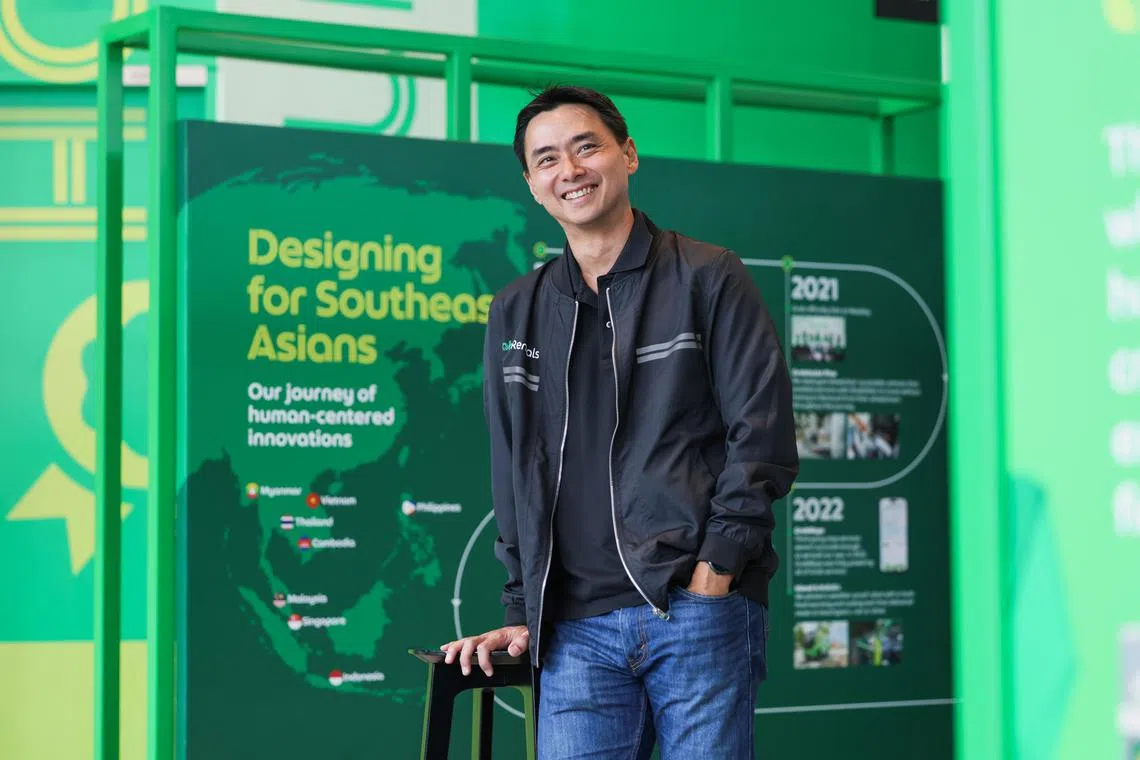Grab eyes future self-driving cars for less popular routes; 2025 focus is on reliability, safety
Sign up now: Get ST's newsletters delivered to your inbox

Grab Singapore managing director Yee Wee Tang said the company is thinking about how autonomous vehicles can complement its pool of drivers.
ST PHOTO: GIN TAY
Follow topic:
SINGAPORE – Grab is open to using autonomous vehicles (AVs) to “fill the gaps” in its ride-hailing service, such as on routes that are less popular with drivers, said the technology company’s Singapore head.
But it will take “many, many years” before AVs, or self-driving cars, can be rolled out in Singapore “on a big scale”, Mr Yee Wee Tang, managing director of Grab Singapore, told The Straits Times in a wide-ranging interview on Feb 21. “It’s very early days for us.”
Mr Yee said Grab is thinking about how AVs can complement its pool of drivers. “For example, are there certain routes that drivers just don’t like?”
Noting that Grab cannot currently say “I have reliable service” in certain areas, such as at the Singapore Zoo in Mandai, he added: “So there are certain routes where AVs can fill the gap – and we are trying to see whether that’s possible.”
On Feb 20, Grab chief executive Anthony Tan said in an earnings call that the firm is in “active discussions” with regulators and potential partners to adopt AVs. Grab Singapore did not confirm whether it is in talks with the Land Transport Authority about AVs.
This is not the first time that Grab has tested the waters when it comes to AVs. In 2016, the firm partnered start-up nuTonomy for a two-month trial of an on-demand driverless car service for a select group of Grab users.
As for Grab’s 2023 bid to purchase taxi operator Trans-Cab, which was called off in 2024,
He added: “We really felt that Grab could have played a role, in terms of (introducing) more technology into the taxi industry. On top of that, Trans-Cab also had very good assets.”
The proposed buyout by Grab’s car-rental arm GrabRentals would have seen it take over Trans-Cab’s 2,000 taxis and more than 300 private-hire vehicles, as well as the taxi operator’s vehicle workshop and fuel-pump operations.
The deal was abandoned after Singapore’s competition watchdog said in a provisional ruling that the acquisition was likely to lead to a substantial reduction of competition in the ride-hailing market, thereby infringing Section 54 of the Competition Act, which prohibits anti-competitive mergers.
When asked, Mr Yee would not comment on whether Grab remains interested in entering the taxi market.
He said Grab’s focus in 2025 will be on service reliability, safety and inclusivity.
In addressing service reliability, the company is taking a lateral approach by offering a free shuttle bus service to and from Sentosa – a location that Mr Yee says, “regardless of all the things we have done, we can never bring enough drivers there”.
In a three-year partnership with Sentosa Development Corporation that started in December 2024, Grab operates six shuttle buses to take people from Beach Station to HarbourFront bus interchange, and vice versa.
These buses run at 10-minute intervals on Fridays, Saturdays and Sundays from 6pm to 9pm. On public holidays and long weekends, they run every 10 minutes between 3pm and 6pm, and every five minutes from 6pm to 9pm.
An average of 80 to 90 passengers use the shuttle service per day, a Grab spokesperson said. Over the first two days of the Chinese New Year, the service saw a total of 900 passengers.
Mr Yee said starting a shuttle service “was the right thing to do for the consumers”, who can more easily book a ride from the mainland.
Grab is also betting big on its premium services, including a new luxury airport transfer service that it started testing in February. Bookings are on the limo.grab.com website, and about 30 limousine drivers are currently on the platform. There are no current plans for this service to be linked to the app, as it caters to travellers.
New services are also in the pipeline. To help passengers find a ride faster, a “mega JustGrab” service – where multiple ride types such as JustGrab, GrabCar and GrabShare are pooled into one service type – is being evaluated. This will give passengers access to a much larger fleet, and generate more demand for drivers.
Asked to comment on passenger feedback about Grab’s high fares and drivers’ complaints that their earnings are too low, Mr Yee said this was a “healthy tension”.
“We are a marketplace, so we always try our best to match demand and supply. Naturally, there are consumers who feel the prices are too high, but if the fares are too low, drivers won’t be here (on the app),” he said.
For drivers, a new feature called GrabRideGuide, which was rolled out to drivers in February, offers a dynamic real-time demand map.
Grab said this artificial intelligence-powered tool suggests optimal routes not just for the current ride, but also better places the driver for future pickups.
The tool is more “prescriptive” than its predecessor, and tells drivers exactly where to go instead of showing them a “hot spot” map. “It’s a win-win situation for everyone,” Mr Yee said.
On safety, Grab plans to improve its telematics system within the driver version of its app, to more accurately detect crashes during rides and provide “faster, more reliable support when needed”, a spokesperson said. Telematics is the integrated use of telecommunications and informatics to collect, transmit and analyse driving patterns, including acceleration and braking.
On the inclusivity front, from the second half of 2025, persons with disabilities who use the company’s GrabAssist and GrabAssist Plus services will have up to 15 minutes – instead of the current five minutes – to get to their pickup points before a waiting fee is incurred. This will ease their worries about driver cancellations and additional charges, Mr Yee said.
Persons with disabilities will need to update their profiles with their concession card details so that Grab’s system will automatically extend the longer wait time to them.
In February, Grab began to allow the booking of concurrent rides, which allowed users to book separate rides for family members and themselves at the same time. This feature was based on feedback from users, Mr Yee said.
Looking further into the future, Mr Yee said the new Johor-Singapore Special Economic Zone
“Given that we have operations, both here and in Malaysia, of course, we think there’s an opportunity for us to play a part. But it’s still early days. We are trying to at least provide certain services, cross-border services,” he said. He added that Grab is in discussions with regulators “to see whether we can play a part in that”.
Aside from ride-hailing, Grab acquired restaurant-reservation platform Chope
Mr Yee said: “Our goal this year is to complete the integration (of Chope and Grab), and hopefully... you can book a reservation, we give you a ride to that restaurant, you can make payment through our app, and we can bring you home as well.”
Vanessa Paige Chelvan is a correspondent at The Straits Times. She writes about all things transport and pens the occasional commentary.


